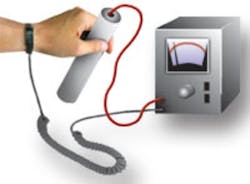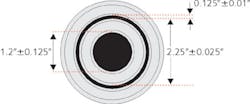Interpreting a data sheet for a static-control product requires a certain level of knowledge and experience. Often, you must wade through myriad specifications, test methods, and claims without fully understanding what is actually stated. It also is possible that the supplier of the product has used incorrect test methods to substantiate the properties of interest.
The ESD Association provides standards and information regarding the application of test methods for various static-control products to help educate the industry. Without question, the most important attributes of a static-control product pertain to electrical resistance in some way. In almost every case, the fundamental function of a static-control product relates to the electrical property that controls the rate of current flow, specifically electrical resistance.
Basically, there are four ways to express electrical resistance:
- Resistance to ground (ohms).
- Resistance point to point (ohms).
- Resistance (ohms).
- Resistivity (ohm·meter).
Each of these forms has an appropriate and acceptable application. Each form also is misused, perhaps more frequently than used correctly. You may notice that the often-used resistivity term ohms/square is not listed. This article supports the internationally accepted technical convention that ohms is the correct term for surface resistance.
Resistance to Ground
Resistance to ground is a measurement that indicates the capability of an item to conduct an electrical charge (current flow) to an attached ground connection. The higher the resistance in the path, the more slowly the charge will move though that defined path.
Many static-control items are evaluated for functionality by measuring electrical resistance through the intended primary path to ground. Wrist straps and static-control footwear, while worn, are evaluated by a loop-resistance measurement that is conceptually the same sort of measurement (Figure 1, right).
Items such as conductive and dissipative floors and worksurfaces also fit into this category but require a standardized contacting electrode. A 5-lb, 2.5″ dia electrode attaches to an instrument that will make the resistance measurement at 10 V for conductive items and 100 V for dissipative items. The second measurement lead from the instrument goes to either the grounding point or the static ground.
Most often, the measurement is a loop resistance between the electrode and the grounding point of the floor or worksurface. In most cases, the resistance from the grounding point to actual ground, such as the equipment grounding conductor bus bar at the main service entrance to the facility, is measured using a specialized ground tester. An example of a loop-resistance measurement or resistance to a grounding point is the system wrist-strap test shown in Figure 1.
Another example of loop resistance comes from the ANSI/ESD S4.1-1997: Worksurfaces—Resistance Measurements. For this test, the standard electrode is placed on the tabletop surface. One wire from the test instrument attaches to the electrode and the other to the grounding point. The single electrode is moved to multiple locations on the worksurface to monitor variations of resistance to the grounding point.
Resistance Point to Point
A point-to-point measurement used during the qualification process evaluates floor and worksurface materials, garments, chair elements, some packaging items, and many other static-control materials. Two electrodes contact the item-under-test at some prescribed spacing. As in the resistance-to-ground test, the measurement voltage depends on the material: 10 V for conductive items and 100 V for dissipative ones. Figure 2 shows the point-to-point concept for a worksurface.
Figure 2. Measurement of Worksurface Resistance Point-to-Point
Point-to-point measurements are important during the qualification process for proper evaluation of flooring and worksurface materials. After installation, the resistance-to-ground measurement is more applicable since it emulates how the material really behaves in practice.
At this time, a single electrode containing two small probes is under evaluation by the ESD Association’s Two Point Resistance (Packaging) WG-11.13. This probe, intended to measure packaging materials, is sure to find many other applications.
Resistance
The measurement of resistance requires that the electrode or electrodes be defined for the specific and intended application. ESD STM 11.11: Surface Resistance Measurement of Static Dissipative Planar Materials delineates a convenient electrode for surface-resistance measurement. Figure 3 shows the concentric-ring contact areas described in this standard.
Figure 3. Dimensional Details of Resistance-Measurement Electrode
The electrode is similar in geometry to one of the electrode configurations described in ASTM D 257: Test Methods for D-C Resistance or Conductance of Insulating Materials. However, the ASTM standard is intended for use with insulating materials.
Numerous papers, articles, discussions, and industry arguments have occurred over the past 25-plus years regarding the use of the ASTM method for static-control material testing. The introduction of ESD STM 11.11 was the result of industry-association agreement regarding the acknowledged problems in using ASTM D 257 for the static-dissipative range of materials.
An electrode meeting the description shown in Figure 3 is available from many static-control instrument suppliers. To use the electrode, simply place it on the material, activate the measuring voltage, and obtain the reading in ohms.
For unknown materials, the measurement should start at 10 V. If the reading obtained is less than or equal to 1 × 106 W, record the value. If the reading is greater than 1 × 106 W, change the applied voltage to 100 V and repeat the test.
The geometric configuration of the concentric-ring probe allows a conversion of the values obtained from ohms to ohms/square if needed for specification purposes. Multiply the reading obtained in ohms by 10 to convert to ohms/square.
Resistivity
Some materials have a level of conduction through their volume as well as exterior surface. These materials are tested using ASTM D991-89(2000)e1: Standard Test Method for Rubber Property-Volume Resistivity of Electrically Conductive and Antistatic Products or ANSI/ESD STM 11.12-2000: Volume Resistance Measurement of Static Dissipative Planar Materials.
The methods, most applicable to samples of a material, may be difficult to apply to some finished items. Regardless of whether a 4-bar or concentric-ring electrode configuration is used, the measurement potential and current are applied to one side of a sample, and the current that flows through the bulk of the sample to an electrode on the opposite side of the sample is measured.
The ESD Association method actually reports the values in ohms, but the expression of ohm·centimeters can be made with a simple conversion discussed in Appendix A of ESD STM 11.12. However, care must be taken since the conversion only applies to homogeneous materials.
Conclusions
It is important to understand a material’s construction and composition before attempting to make an electrical measurement. Ask questions of suppliers to verify material construction.
It is equally important to understand the intended application for a static-control material before making a selection. The material supplier should be able to offer advice regarding the use of a material in a given application.
Always try to envision where the static charge comes from or where you want it to go before choosing a solution methodology or deciding on a test procedure. Applying an improper material to solve a problem is perhaps worse than doing nothing at all. Testing materials with an inappropriate method and making decisions based on erroneous results can only lead to problems.
About the Author
David E. Swenson recently retired from 3M Electronic and Interconnect Solutions Division and started Affinity Static Control Consulting. A member of the ESD Association since 1984, Mr. Swenson is a director of the association, exhibitor liaison, member of the Standards Committee and the ANSI/ESD S20.20 Task Team, and program manager certification team leader. He also was the 1997 EOS/ESD Symposium general chairman, senior vice president in 1996 and 1997, and president in 1998 and 1999. Affinity Static Control Consulting, 2606 Quanah Dr., Round Rock, TX 78681, 512-244-7514, e-mail: [email protected]
FOR MORE INFORMATION
ESD Association standards
www.rsleads.com/307ee-176
ASTM standards
www.rsleads.com/307ee-177
Return to EE Home Page
Published by EE-Evaluation Engineering
All contents © 2003 Nelson Publishing Inc.
No reprint, distribution, or reuse in any medium is permitted
without the express written consent of the publisher.
July 2003



